
Instant Messaging Apps have changed the way we communicate. Billions of users worldwide use these apps in their daily lives to chat, share, and stay connected in real time. But have you ever wondered how these apps make money when they don’t charge users? It’s not just the ads alone; these platforms are leveraging powerful monetization strategies to generate sustainable revenue streams. In this blog, we’ll explore how your favorite chat apps are turning conversations into cash.
Let’s first set the scene with some latest statistics about instant messaging apps.
Latest Instant Messaging Apps Statistics 2025
Instant messaging has had a massive impact on digital communication. Here’s what the numbers reveal about the latest app trends, user engagement and growth.
- As per Statista, in 2021, approximately 3.09 billion mobile phone users accessed over-the-top messaging apps to communicate. This number is estimated to grow to 3.51 billion users in 2025.
- In January 2025, Meta-owned chat and communication app WhatsApp was the most downloaded mobile messenger app worldwide, with over 57 million downloads. Mobile social and communication app Snapchat ranked second with approximately 30 million downloads, while Telegram ranked third with approximately 27.6 million downloads worldwide. (Source: Statista)
- WhatsApp has a whopping 2 billion monthly users. That’s around a quarter of the global population.
- According to data.ai intelligence, WhatsApp users worldwide on the Android app spent 16 hours and 32 minutes per month, or 33.1 minutes per day on the app between 1 March and 31 May 2024. (Source: DataReportal)
- In the early days of the COVID-19 pandemic, people spent a total of 15 billion minutes on WhatsApp calls each day.
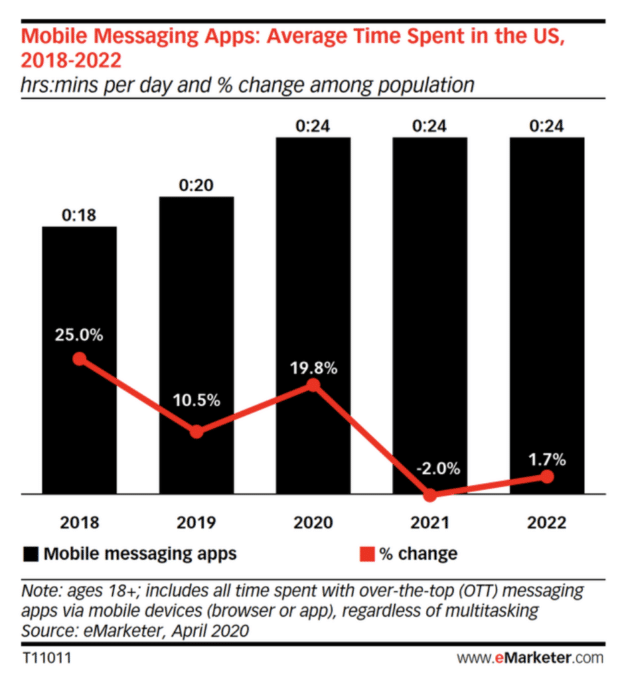
One thing is clear – the user growth and engagement statistics show no signs of slowing down. Messaging apps are here to stay, and the year 2025 is just the beginning of what’s to come.
Top 5 Most Popular Instant Messaging Apps in 2025
The graph below clearly highlights the top instant messaging apps based on the number of active users per month.
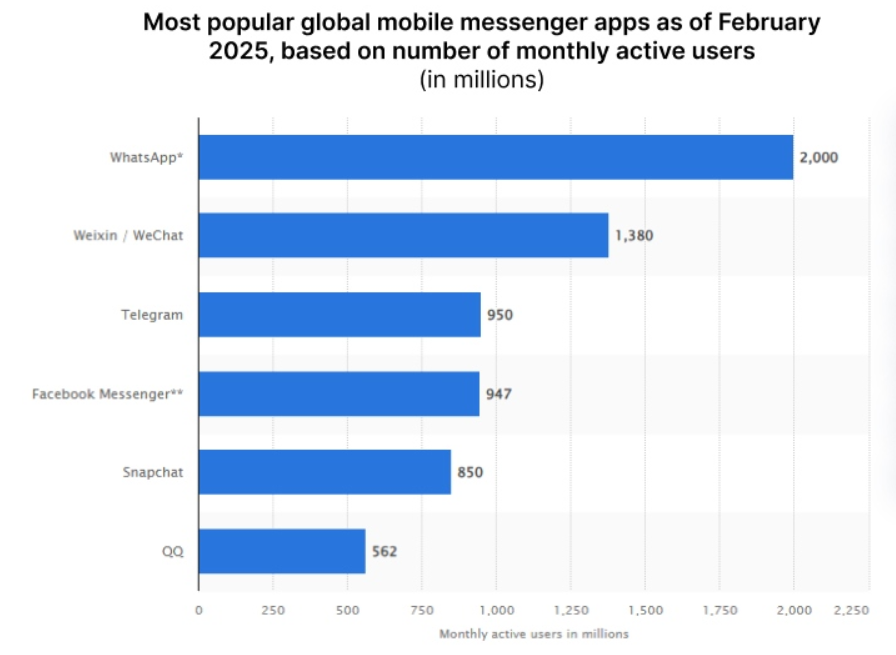
Let’s learn more about each of these apps:
WhatsApp became the most downloaded app in the world in 2022, with a popularity share of 31% of the world. The majority of WhatsApp users are located in India. This is followed by Brazil, Indonesia, the United States, and Russia.
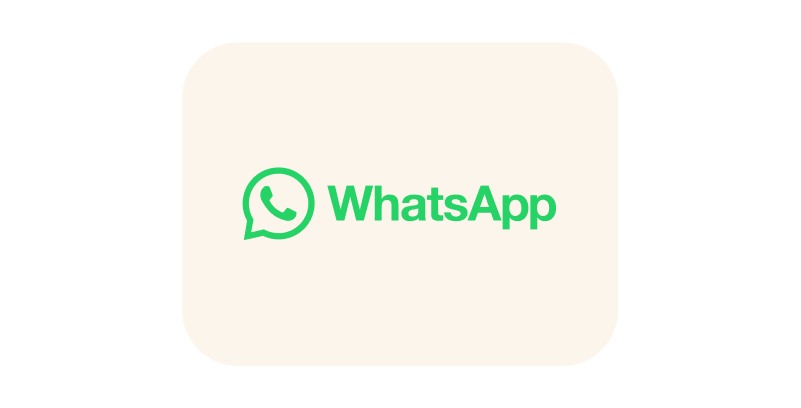
The reason for this success is the fact that WhatsApp provided a free online messaging alternative to SMS and any other means of instant messaging available. Besides that, users can communicate via voice and video messages as well as voice and video calling. They can share documents, images, files, and locations with each other. The app supports 60 languages and sends 100 billion messages daily.
Interesting Insights About WhatsApp
- WhatsApp was founded in 2009 by Jan Koum and Brian Acton and was acquired by Facebook (now Meta) in 2014 for $19 billion.
- In the year in which WhatsApp surpassed Facebook Messenger, it grew by 35%, whereas Facebook had 20% growth that year.
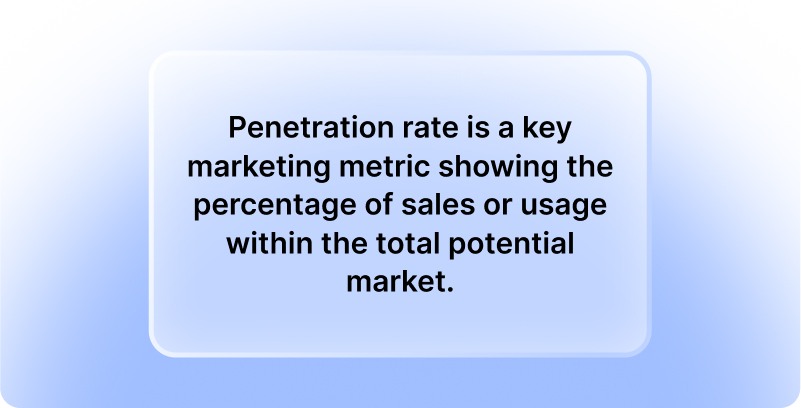
- Statista’s data on the most popular messaging apps by country reveals that WhatsApp has an impressive 87.40% user penetration rate in Saudi Arabia.
We Chat

Launched in 2011, the messaging app WeChat had over 1.24 billion users in the first quarter of 2022. It was created by Tencent, the Chinese Tech Company. Today, WeChat ranks as the second most popular messaging app in the world, with users spending an average of 82 minutes on the platform each day.
In China, WeChat is a leader in the instant messaging app business. It holds a significant market share, with about 1.3 billion monthly active users, and around 80% of the top 500 companies in China are registered as WeChat corporate users.
Interesting Insights About WeChat
- The point that makes WeChat favorable to the rest is the fact that it has numerous integrated “mini-apps” that cover a variety of services.
- Also, its payment function, called WeChat Pay, is a winning point.
- 16.5% of the global population uses WeChat, out of which 52% of WeChat users are male and 42% are female.
Facebook Messenger
Messaging apps are becoming the new domain for businesses to display their ads. However, there are many ways other than ads for businesses to tap into the messaging market. Therefore, companies are effectively using Facebook Messenger to communicate with their potential or ongoing customers.
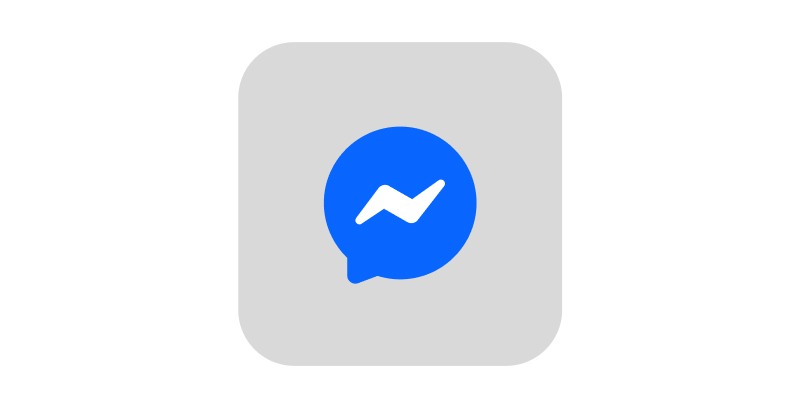
According to data that Facebook provided, in the first quarter of 2025, Facebook Messenger had an estimated 947 million monthly active users. This makes it the third most popular global messaging app, behind WhatsApp (2 billion) and WeChat (1.3 billion).
Chatbots are regarded as the future of marketing and customer service. In 2018, an announcement made by Facebook revealed that there were over 300,000 chatbots on their Messenger platform. Messaging app statistics further show that this is three times more than the previous year, when there were only 100,000 bots on Messenger. (Source: Medium)
Interesting Insights About Facebook Messenger
- Messenger accounts for 52% of the messaging app market, while WhatsApp has an 84% share.
- Over 100 billion messages are sent daily across Messenger, WhatsApp, and Instagram. More than 1.3 billion pictures and videos are exchanged on Messenger each day.
- The 25-34 age group is the largest share of Messenger users.
- India and the Philippines are significant markets for Messenger, with 109 million and 61.8 million active users, respectively, as of January 2025.
Telegram
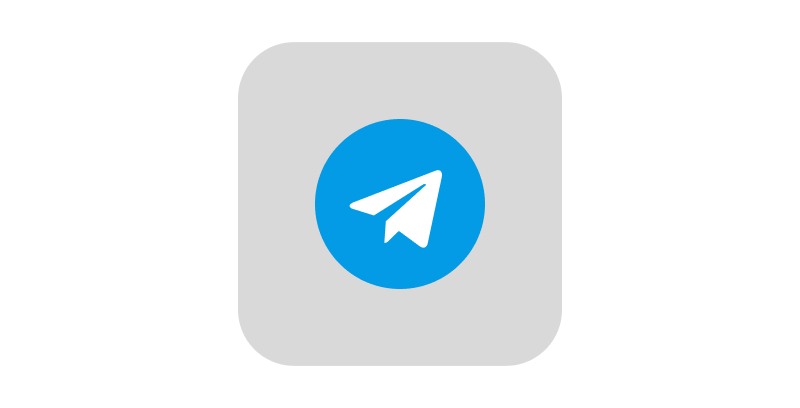
With a strong emphasis on security, Telegram is another instant messaging app widely popular in Europe, Asia, and Africa. Telegram was founded in 2013 by Nikolai and Pavel Durov, who also founded VKontakte, Russia’s version of Facebook.
Telegram’s largest user base is from India, and it has over 1 billion monthly active users. The extensive feature set offered by the app highlights end-to-end secret chats, large file sharing (up to 2GB), and the ability to create groups with up to 200,000 members.
Interesting Insights About Telegram
- Russia accounts for 46.7 million of Telegram’s daily active users.
- ‘News’ is the leading content category on Telegram, with 85% of users following at least one news channel.
- Telegram connects with 9.9% of the global population. The platform’s user base is 57.5% male and 42.5% female.
- Telegram is one of the top 5 most downloaded apps globally.
SnapChat
The primary purpose of creating Snapchat was to enable a way for private, ephemeral photo and video sharing, i.e., to let users share temporary photos and videos that would disappear after being viewed. However, over time, the app significantly evolved beyond disappearing messages. It introduced Stories in 2013 and leveraged Augmented Reality to launch lenses and face filters, attracting younger audiences.
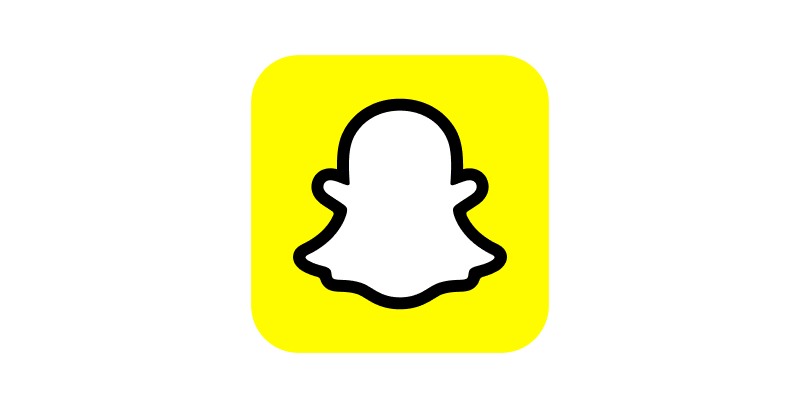
Today, Snapchat is investing heavily in AR for businesses, including virtual try-ons, brand lenses, and tools for the retail and fashion sectors.
Interesting insights about Snapchat
- Snapchat boasts 443 million daily and 800 million monthly active users worldwide, with over 5 billion snaps created daily.
- The most active countries using Snapchat are India (202.5 million), the United States (106.7 million), and Pakistan (31.9 million).
- In terms of gender distribution, Snapchat has around 48.4% male users and 50.7% female users.
- The prominent audience of Snapchat lies in the age group of between 18-24 years.
- When it comes to customer satisfaction, Snapchat scored 74 out of 100 points on the scale.
- Last but not least, an average user opens Snapchat 153.9 times per month.
Revenue Growth Statistics of Popular Messaging Apps
The messaging landscape isn’t just evolving in features—it’s booming in revenue. These numbers tell the story.
WhatsApp (Meta)
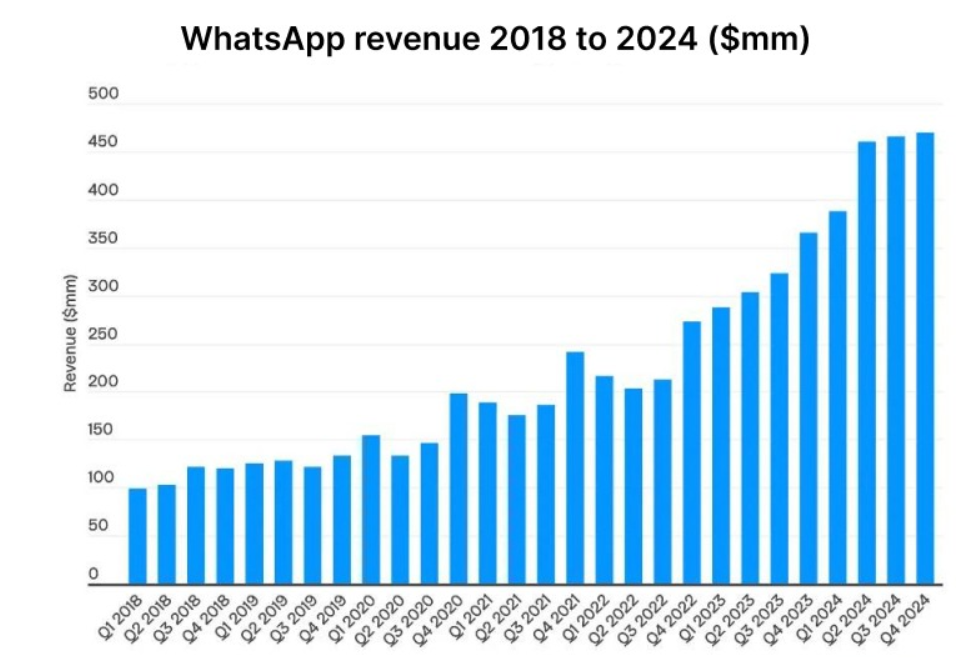
Source: Business of Apps
- Generated $906 million in revenue in 2023, mostly from WhatsApp Business API and click-to-chat ads.
- Business of Apps estimated that WhatsApp generated $1.785 billion in revenue in 2024, almost entirely from WhatsApp for Business.
- Wolfe Research, March 2025, foresees a “high-single-digit to low-double-digit billion-dollar incremental revenue opportunity” in the coming years. They also estimate a massive $30-40 billion Total Addressable Market (TAM) for WhatsApp’s business messaging services in the longer term.
WeChat (Tencent)
- WeChat’s revenue in 2023 was 16.38 billion U.S. dollars. In Q4 2022, WeChat Pay services generated 48.7 billion Yuan, with a growth rate of about 32%.
- WeChat’s global in-app purchase (IAP) revenue reached 33 million U.S. dollars from January 1 to April 10, 2025.
- Revenue streams include mini-programs, payments, ads, games, and enterprise services.
Telegram
- Historically ad-free, but launched sponsored messages and premium subscriptions in 2022.
- Telegram’s total revenue surpassed $1 billion for the first time in 2024, with growth expected from premium offerings and monetized channels.
- Recorded a revenue of around 13.6 million U.S. dollars from in-app purchases worldwide in January 2025.
- In 2024, Telegram generated \$80.6 million in revenue from the Apple App Store and \$35.5 million from the Google Play Store. (Source: Statista)
Snapchat (Snap Inc.)
- Snapchat generated $5.36 billion in revenue in 2024, an increase of 16% year-over-year.
- Major revenue comes from Snap Ads, AR lenses for brands, and Snap Map partnerships.
- North America had the highest ARPU at $9.73, followed by Europe at $2.89 and the rest of the world at $1.19 in Q4 2024.
Facebook Messenger
- As part of Meta, Messenger contributes to a combined ad revenue exceeding $115 billion in 2023.
- Increasing use of automated messaging for business and click-to-message ads is fueling this growth.
Eventually, business communication in different organizations will rely on free and popular mobile messaging apps. Today, popular brands and small businesses around the globe prefer to communicate with their clients and customers through messaging apps. Some recent statistics that underscore this fact are:
- More than 40 million businesses globally are currently using Messenger, with 85% employing it for marketing and customer support.
- On the Messenger app, more than 8 billion messages are exchanged between businesses and their customers per month.
- 5 million businesses utilize the more advanced WhatsApp Business API for scaled communication.
- In key markets like India and Brazil, 80% of small-business owners use WhatsApp to communicate with customers and grow their businesses.
- Over 175 million people message a WhatsApp Business account every day.
- 70% of businesses reported increased customer satisfaction after implementing WhatsApp communication.
- Businesses report saving up to 30-40% on communication or customer service costs by switching to or incorporating WhatsApp Business solutions.
(Source: D7 Networks)
Naturally, many new entrepreneurs and communication service providers are curious about the success stories behind these popular apps. After all, they’ve become an essential part of our daily lives—offering free, cross-platform, and real-time messaging across smartphones, tablets, and computers. Before we dive into the discussion, we can already guess your next question!
How do App Owners Make Revenue from their Instant Messaging Apps?
This question is obvious for those who want to start a business or already own an Instant Messaging App. Whether a newcomer or owner of a messaging app, both need to put more emphasis on making revenue.
There are a few helpful things to help generate that extra revenue from your app. While the user makes calls or sends SMS, the balance will be deducted from the GSM account or the app account.
In addition to this, if there is virtual roaming, it will further add to the revenue as well. According to Grand View Research, Inc., “The global roaming tariff market size is expected to reach USD 100,750.0 million by 2025, registering a CAGR of 5.5%.”
Apart from this, enabling operators to access competitors’ customer base by engaging them with your OTT apps and then sending them different promotional content is an additional bonus in terms of revenue generation. So, here are a few guidelines with references to successful stories to tip you on the smart ways of monetizing your instant messaging app.
Top Ways to Earn From Your Instant Messaging Apps
1. Subscription fee or Download charge
You can develop two versions of your instant messaging apps. One will be free of charge to download and subscribe and another one with a subscription fee which will provide your users with a complete experience.
This free version can work as a teaser because after using the free version of your app, your customers will realize that the app can serve an important role in their lives which they don’t want to miss. If they enjoy what your free app offers and want a better experience, they might be willing to pay for the premium version.
If we consider that your app has 1 billion users and everyone is paying about 1 USD for renewal, it would generate about a billion dollars in revenue per year. As per statistics, in 2023, app subscriptions generated $45.6 billion worldwide. Moreover, In the app market, apps that use subscriptions generate a significant portion of revenue, accounting for 45.4% of the total revenue, compared to 54.6% from non-subscription apps in 2024. (Source: Statista)
2. In-App Purchasing
If we consider Line, which is a popular messaging app in Japan, Taiwan, and Thailand, it generates revenue from two prime areas.
- First are those free-to-play video games that make money from in-game purchases of virtual items and other services.
- The second one is buying “stickers” featuring different emoticons, and real-life cartoon characters that users use to inbox their friends.
Besides this, WeChat can help you hail a taxi, book a dinner reservation, transfer payments, and more. Using Skype and WhatsApp you can avail calling credit as well.
The In-App purchases can also include a variety of other features, such as Personal DID Number for the end-user, Mobile TOP UP, and Money Transfer. Value-Added Services (VAS) can also help to generate more revenue from your OTT Application.
Here instead of Sending VAS content in SMS, an operator can send it through IM message to the end-user. This, therefore, helps to save SMS costs and also generate profit from VAS Services. And as IM supports rich content so it is possible to send a variety of content.
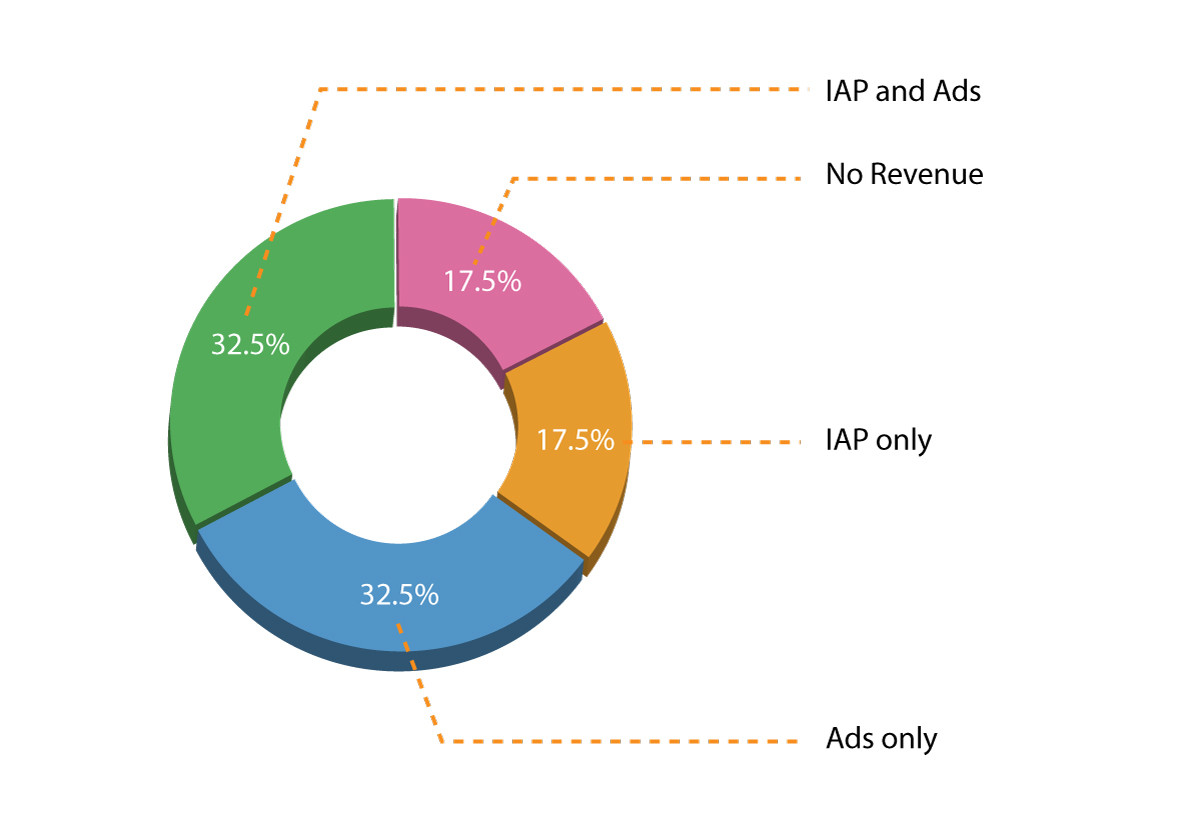
This pie-chart shows the information on how mobile apps generate revenue. According to Sweetpricing, research shows that 32.5 % of mobile apps are making revenue both from In-App Purchasing (IAP) and In-App Advertising.
3. In-App Advertising or Personalized Ad Targeting
In your instant messaging apps, you can add in-app advertisements through digital marketing. But how?
Well, your users always log in to your instant messaging app using their Email account/Phone numbers/ Facebook account. When these people log in, data is entered into the app, and the analytics server can easily track your customer’s behavior, likes, and tastes. Based on their interest, likes, and dislikes, you can show ads to them whenever they are using your messaging app.
Personalized Ad targeting through the segmented user base helps to reach the target audience with more precision and in turn, helps to generate revenue for the app. According to McKinsey’s study, companies using “data-driven personalization as the core factor for marketing and sales decisions can improve marketing ROI by 15% to 20%”.
This step increases the chances of making revenue, as you are only showing the things your customer wishes to see. However, you should be careful that this process does not hamper your user’s experience. LINE Messenger and WeChat are the few OTT communications players to demonstrate revenue from In-App advertising.
Business Communication Solution through FREE Instant Messaging Apps
It is the unmatched convenience and cost-effectiveness of free and instant messaging apps that have become the preferred mode of communication. As a result, these apps are rapidly gaining traction among entrepreneurs, communication service providers, and VoIP vendors who wish to tap into this growing market.
Now, let’s move to the real part:
If you too are enthusiastic about launching a instant messaging app, but thinking that it could take years to build a powerful one, then we have a good news for you.
We empower service providers with the REVE Voice, Video & Messaging App – a Complete White-Label IP Communication Solution that delivers all the features and functionalities of popular platforms like WhatsApp and other such platforms. Think of it as giving you the power of WhatsApp, Signal, or Viber — but with your name, your branding, and your control.
Key Highlights of REVE:
- Custom Branding for Your App
- Free Calling Between App Users
- Make GSM Calls via Wi-Fi or Mobile Data
- Offer Premium Value-Added Services
- All Major Platforms Supported
If you want to launch a community app, a corporate communication tool, or even a regional messaging platform, REVE’s solution cuts the cost, time, and complexity, while giving you enterprise-grade performance from day one.
Key Takeaway!
To summarize, Free Messaging Apps or Instant Messaging Apps are the main targets of communication in recent days because of the highest level of convenience and cost-effective features. So, this business is emerging for entrepreneurs, communication services providers, and VoIP service providers who know about developing mobile messaging apps with multiple features.
Frequently Asked Questions
How do free instant messaging apps make money?
Free instant messaging apps typically make money through indirect monetization strategies. Since most users expect messaging apps to be free, companies generate revenue via advertising, in-app purchases, subscription models, API access for businesses, premium features, or even financial services. For example, WhatsApp earns revenue from its Business API, while apps like LINE and WeChat generate money through ads, games, and e-commerce services.
What are the main monetization models used by messaging apps?
The primary monetization models include:
- Advertising: Displaying ads within the app.
- Freemium Model: Basic services are free, while users pay for advanced features.
- In-App Purchases: Selling digital items like stickers, themes, or games.
- Subscription Services: Offering ad-free or enhanced versions for a recurring fee.
- Business Tools & APIs: Charging companies to use APIs for customer communication.
- Value-Added Services: Such as mobile payments, streaming, and cloud storage.
Do messaging apps sell user data to generate revenue?
Most reputable messaging apps do not sell user data outright. However, some may use aggregated or anonymized data for advertising or product improvement purposes. It’s essential to review an app’s privacy policy to understand its data practices.
How do in-app purchases work in messaging apps?
In-app purchases let users buy virtual goods or premium content within the app. This may include:
- Stickers and emoji packs
- Custom chat themes
- Games or game credits (in super apps like WeChat or LINE)
- Cloud storage or file sharing upgrades
These purchases are processed through app stores, with a percentage of revenue shared with the platform.
What role does advertising play in monetizing chat apps?
Advertising is one of the most common revenue streams for messaging apps. Ads can be shown in various formats:
- Banner ads
- Sponsored messages
- Click-to-message ads (like in Facebook Messenger)
- In-feed ads (e.g., WeChat Moments)























